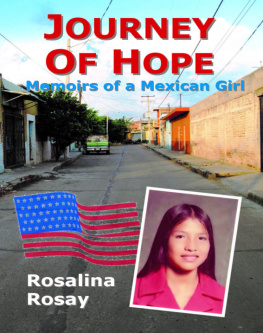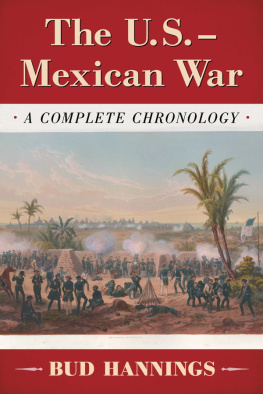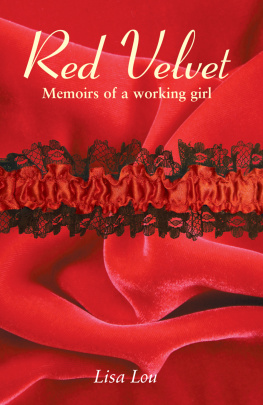Journey of Hope
Memoirs of a Mexican Girl
Rosalina Rosay
AR Publishing Company
Los Angeles, California
www.arpublish.com
Copyright 2007, 2010 Published by ARPublishing Company at Smashwords. All rights reserved.
Smashwords Edition, LicenseNotes
This ebook islice nsed for your personal useonly. This ebook may NOT be re-sold or given away to other people.If you would like to share this book with another person, pleasepurchase an additional copy for each person you share it with. Ifyoure reading this book and did not purchase it, or it was notpurchased for your use only, then please return to Smashwords.comand purchase your own copy. Thank you for respecting the hard workof this author and publisher.
Printed copy orders, inquiries, and contactinfo:
www.arpublish.com
ISBN-13: 978-0-9800361-8-3
ISBN-10: 0-9800361-8-6
Library of Congress Control Number:2007908073
Library of Congress subject headings:
Rosay, Rosalina
Mexican American women California Los Angeles Biography
Mexican Americanwomen Biography
Immigrants California Biography
Immigrants Mexico Biography
Mexican American college students
Women authors, Mexican American
California Biography
Illegal Immigrants
Amnesty United States
Published by Rosalina Rosay and ARPublishing Company at Smashwords
To my children, Alex, Andrew, and Ariana,
who after reading this book, love andappreciate America even more
~ ~ ~
And to my brothers, Jose and Alfonso, whohave shown great kindness throughout the years
Contents
Acknowledgments
Authors Notes
Part One: Poverty and Deprivation
Part Two: Hope and Opportunity
Epilogue
Final Thoughts
Acknowledgments
Thank you to my wonderful caring husband,Claude, who with his publishing experience, helped make this book areality.
To Victor Wortman for his support throughoutthis experience and for his help editing the initial and finalversions.
To Bob Cody for his attention to detail inediting my work.
Authors Notes
Some of the names in this book have beenchanged in order to maintain the privacy of certainindividuals.
Most of the book was written to reflect thevocabulary and wisdom of the child and teen at that particulartime.
About the Cover
The picture on the frontcover is the street where I grew up. The appearance of the streethas not changed much (the cobblestones have been paved over). Whathas changed is the number of people out on the street. In the latesixties and early seventies at six oclock in the evening the time of day whenthe picture was taken you would see kids playing, moms gossiping, andpeople running errands. This was the time when moms were finishedcleaning up after the three oclock supper, dads were done withtheir siestas, and kids were finished with theirhomework.
The street is now empty because most of thehouses have either been abandoned or the parents who stayed behindhave passed away. Most of the people who used to live here now livein America.
The picture on the back cover is the plaza,and it is also a recent picture. The plaza has not changed muchsince I lived there. Like my street, the plaza seems empty.
Other pictures available to view/copy/printat no charge at: www.arpublish.com
Part One
Poverty and Deprivation
I do not know exactly how old I was when Istarted to admire America, but I think I was quite young because mymemory of this feeling is more foggy and distant than any other.Even at that young age, I knew that America was a place wheredreams could come true and once you made it there, you would neverwant to leave.
I guess I knew this because my oldestsister, Teresa, (who was old enough to be my mother) was alreadyworking in America or El Norte (The North) as we usually calledit. She headed there after her husband left her and their threekids. She was working as a maid and nanny and would always sendmoney for her children.
Her kids lived in our house and she actuallysent more than money. She sent beautiful clothes, made from allkinds of soft wonderful materials unlike our regular clotheswhich, for the girls, consisted of stiff cotton dresses made by ourneighbor. She also sent white, creamy, fragrant soaps that wereeasy to hold and much different than the big, brown, non-fragrantbars of soap the whole family normally shared. But what I loved themost were the pictures she sent bright, colorful pictures of herand the children she cared for. These pictures showed theirbeautiful pool, with water that looked so clean and blue that Icould not believe my eyes. The pictures also showed lush greengardens and the inside of the familys house, which to me was evennicer than the houses shown on Mexican soap operas.
My two oldest brothers, Jose and Alfonso,(who were also old enough to be my parents) were living in Americaas well. They were working as gardeners and whenever my oldestbrother, Jose, was deported back to Mexico, he would immediatelytry to get back to the United States. He hated returning to ourhouse a crowded mud-brick house with dirt floors and nobathroom.
Unlike America, Mexico around the latesixties was a very bad place to live, especially for children.There were so many of us. My mother had six sons and four daughters not including the ones that had died as babies. Most women mymothers age had eight, nine, ten kids, often giving birth tobabies around the same time as did their oldest daughters as wasthe case in our family.
With so many children in our town, it wasvery difficult for most kids to obtain the love, respect, andattention that they needed. If you had parents that lived inAmerica sending you money, you got respect. If you were pretty, yougot love. If you were a male, you got attention. I had none of thethings that seemed to make a kid special.
Just like our town, our house at this timewas full of kids six of my moms own kids, my oldest sistersthree kids (whom I called my cousins because the girls were olderthan me and the boy was only a year younger) and two babies on theway. One of the babies on the way belonged to my second oldestbrother Alfonso. His pregnant wife was living with us and sheoccupied the only bedroom that did not have a dirt floor. Thesecond baby on the way belonged to my sixteen year old brother,Manuel, who had married his fourteen year old girlfriend a fewmonths before. They occupied one of the dirt floor bedrooms. Theirdirt floor had to be wetted daily so there would not be dust flyingeverywhere. The third bedroom had to be shared by the rest of us.Unlike the dusty bedroom, this room was always damp since it gotvery little sunshine and during the rainy months the mud walls gotvery wet and they did not seem to dry the whole year. The onlythings in this room were three beds. I slept on one of these bedswith my sister Catalina and my two girl cousins. Two of my brothersand my male cousin shared another. My father, mother, and youngestbrother shared the third bed. My youngest brother wetted this bed.Dampness and the smell of urine permeated this room much of thetime.
I am five years old and I am lying on thebed in our damp and pungent room. Its late in the evening and theroom is dark since it has no electricity and there is only a tinywindow. I am having another bad earache. It hurts so much that allI can do is lie there, crying. I am alone and I am scared becausethe room is so dark and my ear hurts so much. Then I see thesilhouette of a woman with ample breasts come into the room. Shetells me she is going to put breast milk into my aching ear. Iimmediately cooperate because my ear hurts so much and I am hopefulthat the breast milk will make it feel better. The breast milk doesnot help and the pain eventually goes away.






![Avery Moore - Mexican Cookbook 365: Tasting Mexican Cuisine Right In Your Little Kitchen! (Best Mexican Cookbook, Mexican Dessert Cookbook, Slow Cooker Mexican Cookbook, Mexican Salsa Cookbook) [Book 1]](/uploads/posts/book/288399/thumbs/avery-moore-mexican-cookbook-365-tasting-mexican.jpg)


